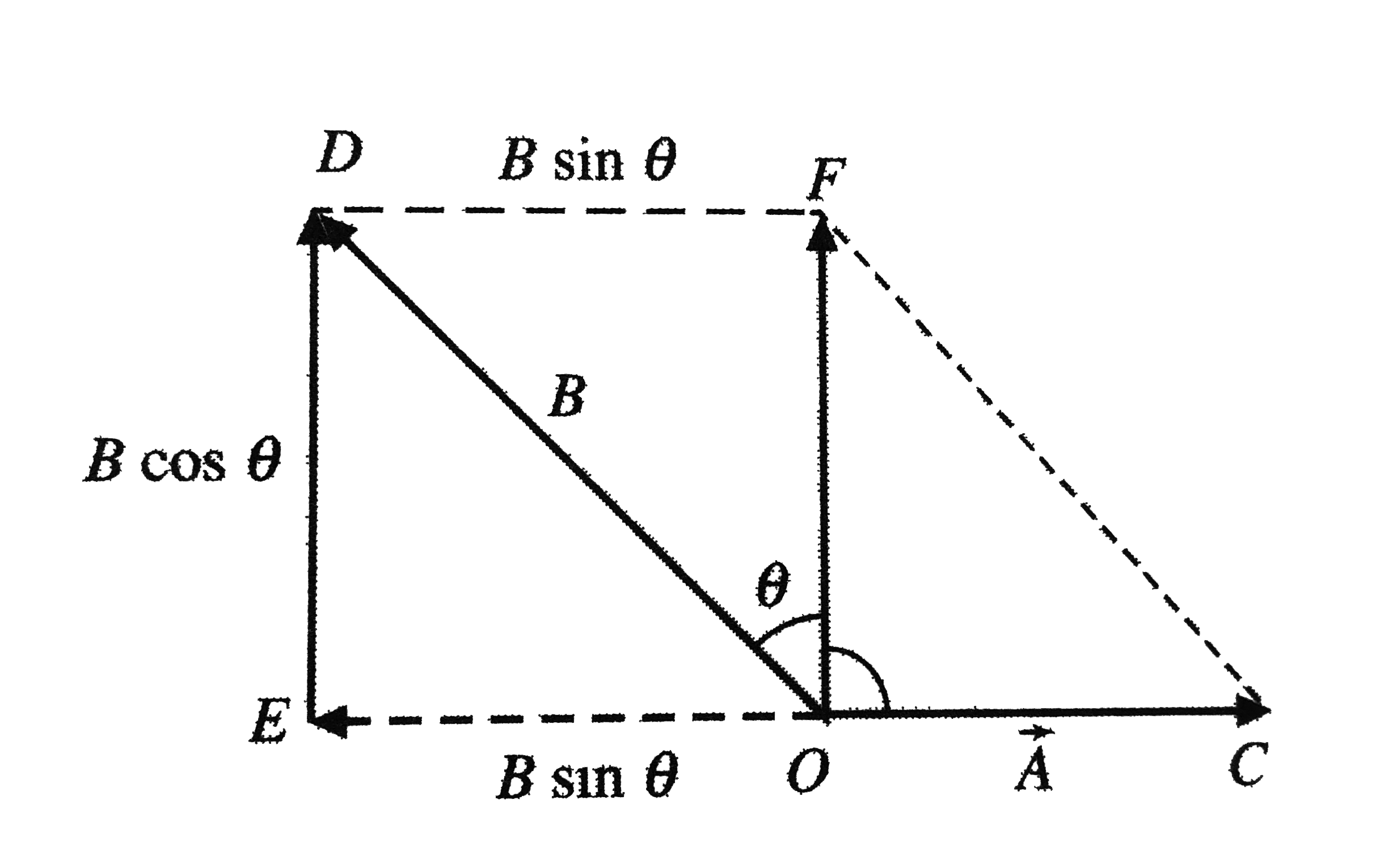Resultant of two vectors →Aand→B is of magnitude P, If →B is reversed, then resultant is of magnitude Q. What is the value of P2+Q2 ?
2(A2+B2)
2(A2−B2)
A2−B2
A2+B2
The correct Answer is:A
To solve the problem, we need to analyze the two scenarios involving the vectors →A and →B.
Step 1: Understand the Resultant of Two Vectors
The magnitude of the resultant vector when two vectors →A and →B are added is given by the formula:
P=√A2+B2+2ABcos(θ)
where θ is the angle between the two vectors.
Step 2: Resultant When →B is Reversed
When vector →B is reversed, it becomes −→B. The new resultant vector Q can be expressed as:
Q=√A2+B2−2ABcos(θ)
This is because reversing →B changes the sign of the cosine term in the formula.
Step 3: Calculate P2 and Q2
Now, we can calculate P2 and Q2:
1. For P2:
P2=A2+B2+2ABcos(θ)
2. For Q2:
Q2=A2+B2−2ABcos(θ)
Step 4: Add P2 and Q2
Now, we add P2 and Q2:
P2+Q2=(A2+B2+2ABcos(θ))+(A2+B2−2ABcos(θ))
The 2ABcos(θ) terms cancel each other:
P2+Q2=2A2+2B2
Step 5: Factor the Result
We can factor out the 2:
P2+Q2=2(A2+B2)
Final Answer
Thus, the value of P2+Q2 is:
P2+Q2=2(A2+B2)
The magnitude of the resultant vector when two vectors →A and →B are added is given by the formula:
P=√A2+B2+2ABcos(θ)
where θ is the angle between the two vectors.
When vector →B is reversed, it becomes −→B. The new resultant vector Q can be expressed as:
Q=√A2+B2−2ABcos(θ)
This is because reversing →B changes the sign of the cosine term in the formula.
Now, we can calculate P2 and Q2:
1. For P2:
P2=A2+B2+2ABcos(θ)
2. For Q2:
Q2=A2+B2−2ABcos(θ)
Now, we add P2 and Q2:
P2+Q2=(A2+B2+2ABcos(θ))+(A2+B2−2ABcos(θ))
The 2ABcos(θ) terms cancel each other:
P2+Q2=2A2+2B2
We can factor out the 2:
P2+Q2=2(A2+B2)
Thus, the value of P2+Q2 is:
P2+Q2=2(A2+B2)
Topper's Solved these Questions
- MOTION IN A PLANE BOOK - NCERT FINGERTPS ENGLISHCHAPTER - MOTION IN A PLANE EXERCISE - HOTS
6 Videos
- MOTION IN A PLANE BOOK - NCERT FINGERTPS ENGLISHCHAPTER - MOTION IN A PLANE EXERCISE - EXEMPLER PROBLEMS
9 Videos
- MECHANICAL PROPERTIES OF SOLIDSBOOK - NCERT FINGERTPS ENGLISHCHAPTER - MECHANICAL PROPERTIES OF SOLIDSEXERCISE - Assertion And Reason
15 Videos
- MOTION IN A STRAIGHT LINEBOOK - NCERT FINGERTPS ENGLISHCHAPTER - MOTION IN A STRAIGHT LINEEXERCISE - NCERT Exemplar
6 Videos
Similar Questions
The resultant of two vectors →A and →B is perpendicular to the vector →A and its magnitude is equal to half of the magnitude of the vector →B. Find out the angles between →A and →B.
 .
.
View SolutionMagnitude of resultant of two vectors →P and →Q is equal to magnitude of →P . Find the angle between →Q and resultant of →2P and →Q .
View SolutionThe resultant of two vectors →P and →Q is →R. If →Q is doubled then the new resultant vector is perpendicular to →P. Then magnitude of →R is :-
View SolutionTwo vectors →A and →B are such that →A+→B=→A−→B. Then
View SolutionResultant of two vectors of magnitudes P and Q is of magnitude 'Q'. If the magnitude of →Q is doubled now the angle made by new resultant with →P is
View SolutionFind the magnitude of resultant vector →R of two vectors →aand→b of magnitude 7 and 4 unit respectively if angle between then is 51.3∘. (Given cos51.3∘=5/8)
View SolutionFind the angle between two vectors →aand→b with magnitudes 1 and 2 respectively and satisfying →a.→b.=1
View SolutionThe magnitudes of two vectors →P and →Q differ by 1. The magnitude of their resultant makes an angle of tan−1(3/4) with P. The angle between P and Q is
View SolutionTwo vectors →P and →Q are added, the magnitude of resultant is 15 units. If →Q is reversed and added to →P resultant has a magnitude √113 units. The resultant of →P and a vector perpendicular →P and equal in magnitude to→Q has a magnitude
View SolutionTwo vectors →Aand→B have equal magnitudes.If magnitude of (→A+→B) is equal to n times of the magnitude of (→A−→B) then the angle between →Aand→B is :-
View Solution
